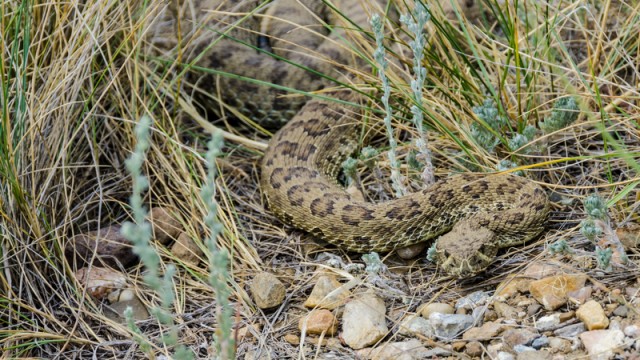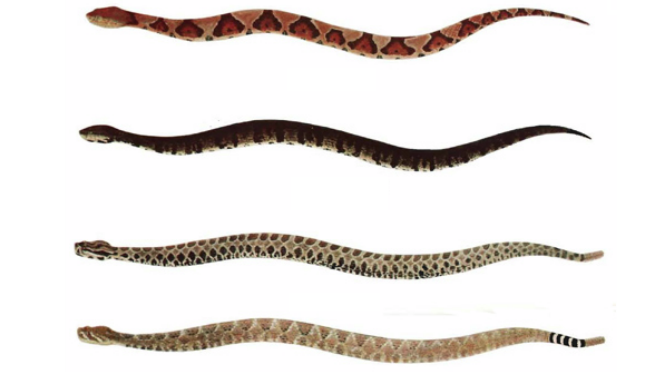Most venomous snakes are nocturnal, but the prairie rattlesnake is commonly active during the daytime. It has similar features to a massasauga rattler, but the difference is in the scales. Watch for paired plates on the massasauga’s head, whereas there are small scales on the prairie rattlesnake’s head that will help to tell them apart.
6 – Prairie Rattlesnake
PRAIRIE RATTLESNAKE (Crotalus viridis). Length 3-4 feet. The habit of denning in large groups is well-known. Several hundred have been found in hibernation in a single den. The food of the prairie rattler is warm-blooded, mostly rodents and small rabbits. It appears to be active in the daytime, whereas the other poisonous snakes are mainly nocturnal. The ground color varies from a light gray to green, and the pattern of dorsal blotches with alternating rows of lateral blotches may cause it to be confused with the smaller massasauga, but the scales on top of the head are all small on the prairie rattler, whereas paired plates are present on the massasauga.
This snake has a wide range over western United States, where it is probably the most common rattlesnake. It is frequently found in prairie dog villages. The burrows of these animals are utilized as shelter and the young are used as food items.
Now that you know about a variety of venomous snakes be sure to check with your state’s Fish and Wildlife organization to see which venomous snakes (if any) inhabit your state or region. Whether you discover one while camping, hiking, or just working out in your backyard as my dad was doing, knowing how to identify dangerous snakes like the ones on this list may save your life!
In case you were wondering, my dad’s bite turned out fine, despite the venomous bite. Thankfully, he did not have to receive the antivenin because the baby rattler had only nicked him. Still, the bite managed to his hand swell a lot for awhile!
Nearly every area of the country has at least one type of venomous snake, so it’s essential you learn which snakes dwell in your area and if you know anyone who enjoys spending time in the outdoors, share this article with them, too. The more people know how to spot and avoid dangerous snakes, the better off we’ll all be.
For more information on venomous and nonvenomous snakes, including what you should do if you get bit, please visit Emporia State University.



Yes Obama. Clinton,Schumer palosi. McCain, cnn
Well , they all look democRATS ,but they are so many of them it’s hard to identify them.
I can identify them only in soup or stews,they fast different .
#1 John mccain#2loretta lynch#3 Hillary clinton#4 jey johnson#6 Maxine Watters,#5obama#
Lynch,OBumer,Schumer ,Pelosie
–
Chuck Shumer
Nancy Pelosi
Elizabeth Warren
John McCain
Maxine Waters
Hillary Clinton
Nope
Guessing here…copperhead, water moccasin, and 2rattlesnakes…..one might be a sidewinder?
Dead snake!
The most important detail about snake bites is the statistic that the great majority of them occur because the victim tried to handle, or kill the snake. They’re easily as afraid of humans as we are them, so just leave them alone.